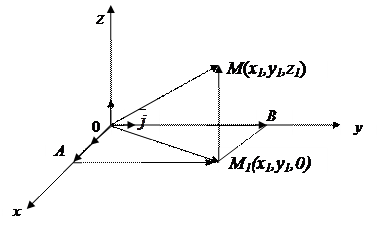
CATEGORIES:
BiologyChemistryConstructionCultureEcologyEconomyElectronicsFinanceGeographyHistoryInformaticsLawMathematicsMechanicsMedicineOtherPedagogyPhilosophyPhysicsPolicyPsychologySociologySportTourism
Decomposition of vectors.
Theorem 1. An arbitrary vector  in the plane can be decomposed into two noncollinear vectors:
in the plane can be decomposed into two noncollinear vectors:
 .
.
Theorem 2. An arbitrary vector  in space can be decomposed into three noncoplanar vectors
in space can be decomposed into three noncoplanar vectors
 .
.
Let  be noncoplanar vectors.
be noncoplanar vectors.
The Cartesian system of coordinates. Consider the following coordinate system: take mutually perpendicular unit vectors  and
and  , draw coordinate axes x,y and z along them, and fix a unit on metric scale:
, draw coordinate axes x,y and z along them, and fix a unit on metric scale:

 ,
,

 .
.
|

Definition. The triple of vectors  is called right if, looking from the endpoint of the last vector, we see that the shorter rotation from the first vector to the second is anticlockwise.
is called right if, looking from the endpoint of the last vector, we see that the shorter rotation from the first vector to the second is anticlockwise.
From the triangle ÎÌÌ1, we obtain
 ,
,
Since the vector  is collinear to the unit vector
is collinear to the unit vector  , it follows that
, it follows that
 .
.
From the triangle ÎÀÌ1, we obtain
 ,
,
because, by analogy, the vectors  and
and  are collinear to the unit vectors
are collinear to the unit vectors  and
and  . Substituting the vector
. Substituting the vector  thus obtained, we see that
thus obtained, we see that
 . (2)
. (2)
Thus, the radius vector  is represented as the sum of
is represented as the sum of  and multiplied by the corresponding coordinates of the point Ì.
and multiplied by the corresponding coordinates of the point Ì.
Consider the vectors
 and
and 
and their sum
 .
.
Under addition the respective coordinates are added
Let us multiply the vector  by a number l:
by a number l:
 .
.
When a vector is multiplied by a number l, each coordinate of this vector is multiplied by this number.
Example. Find the vector  if
if
 ;
;  .
.
Let us find the required vector in vector notation:

 .
.
To find the same vector in vector notation, we multiply the first vector by 4 and the second by –3 and sum their coordinates:



 .
.
Given two points  and
and  in space, find the vector
in space, find the vector  .
.
Thus, we have found the required vector in the coordinate notation:
 . (2¢¢)
. (2¢¢)
To find the coordinates of a vector, we must subtract the coordinates of its tail from the coordinates of the head.
For example, let us find vectors with given coordinates of heads and tails:
Ì1(7;4;–3); Ì2(1;–2;–2);
 ={–6; –6; 1};
={–6; –6; 1};  ={6; 6; –1}.
={6; 6; –1}.
Find the length of a vector  :
:

 .
.
From the right triangle ÎÌ1Ì2 , we find the hypotenuse
 ,
,
 z
z
where  .
.
M1
From the other right triangle ÎÀÌ2 , 0 z1 y
we find the hypotenuse  .
.
Substituting it into À x1
the first hypotenuse, we obtain x y1 M2
 .
.
Thus, the length of a vector is defined by the formula
 . (3)
. (3)
Date: 2015-01-02; view: 1958
| <== previous page | | | next page ==> |
| Linear Operations on Vectors | | | The direction of a vector. Let us find the angle between two vectors and . |
